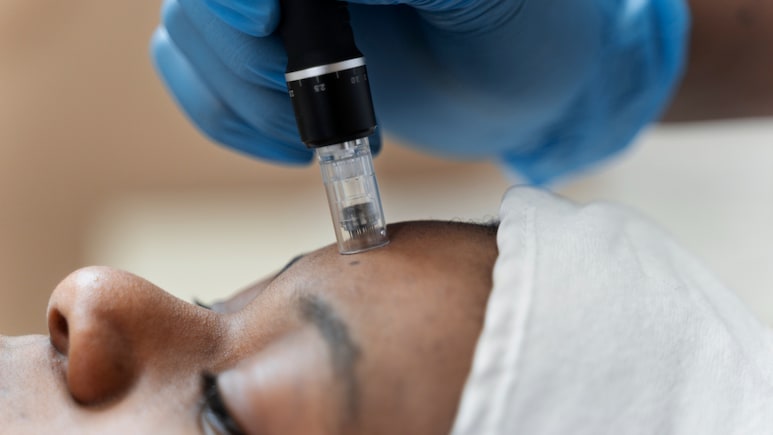
Micro-needling, a minimally invasive beauty procedure that stimulates collagen (the primary building block of your skin) production, is a widely popular beauty treatment that has become easily accessible in India recently. This treatment is used to improve skin texture, reduce scars, alongside better the skin's appearance. But it has risky after-effects, which can range from redness or facial swelling for up to five days. In addition, it is recommended to stay away from the sun until your skin heals after this procedure. This beauty procedure is fast gaining popularity in Indian metros, beauty salons, and clinics, and people across the gender spectrum are undergoing these aesthetic beauty treatments.
While the microneedling market in India is significant and growing robustly at a rapid pace. There is a lack of awareness when it comes to these aesthetic procedures, given the growing focus on self-care and appearance in the digital age. In metro cities like Delhi, Mumbai, Bangalore, and Chennai, a surging number of dermatology clinics, medical spas are performing these procedures. One report by Market Research Future even suggests that urban Indians aged 18-45 are considering cosmetic procedures, highlighting a substantial potential customer base for beauty treatments like microneedling.
But the fact remains, that when done by an untrained hand at a salon, microneedling might lead to more adverse reactions than you know. In any case, in India, salons and other small beauty businesses are not well-regulated. This means that unless you are opting for the right place, your microneedling procedure can go wrong in many ways. The US Food and Drug Administration (FDA) has also issued a global advisory on radiofrequency microneedling procedures, their risks, and complications with consumers.
How Does Radiofrequency Microneedling Work?
Radiofrequency (RF) microneedling refers to devices that use an array of small electrodes, also known as microneedles, to deliver RF energy into and under the skin to produce local heating.
This is how the beauty procedure works, but with the use of these devices for dermatologic or aesthetic procedures intended to improve the appearance of the skin. Mainly, used to treat wrinkles or to achieve skin effects, sometimes referred to as "resurfacing", "tightening", or "rejuvenation".
And the FDA is aware of reports of serious complications (adverse events), including burns, scarring, fat loss, disfigurement, and nerve damage, and the need for surgical repair or medical intervention to treat injuries.
This is alarming as the common microneedling procedures are performed in beauty spas, salons, and beauty treatment centres without any supervision of medical professionals. But the radio frequency microneedling procedures are performed under the supervision of dermatologists and medical professionals.
But, with this recent advisory, it's important to note that you please exercise caution while going for radio-frequency microneedling procedures at beauty clinics.
What Are The Risks Of Radiofrequency Microneedling?
As microneedling involves controlled micro-injuries using fine needles to penetrate the skin and stimulate collagen and elastin (vital proteins responsible for skin elasticity) production. The key differentiating factor of scarring is the needle depth. For this, you need to understand the difference in how this beauty treatment is performed, primarily through which device and where?:
Salon/Home Devices: Typically use superficial needles (0.1 mm -0.5 mm), primarily for product absorption. These devices rarely penetrate deep enough to address serious issues like acne scars.
Clinical Devices(Dermatologist): Use adjustable, motorized pens with needles that can reach up to 2.5mm, which is essential for effective scar revision and stimulating the lower dermis(middle layer of skin in your body).
Note: A beautician focuses on cosmetic application and has minimal formal training in skin anatomy, pathology, or complication management. A dermatologist is a medical doctor who is a skin specialist, capable of comprehensive medical assessment and diagnosis, should a skin abnormality arise during the consultation.
What Are The Factors That Cause Permanent Scarring?
Here are some ways through which people can be affected by the radiofrequency micro-needling beauty treatments:
Improper technique and depth: wrong needle type for the client's specific condition or skin type can be disastrous, as puncturing the skin too deeply. This may result in irreversible fibrotic scarring (formation of fibrous connective tissue in response to injury or inflammation) or even Keloid(overgrowth of scar tissue) formation.
- Catastrophic hygiene failures: Infection is a major risk factor in non-medical settings.
- Ignoring advanced skin conditions: only a dermatologist can properly screen for underlying conditions.
- Post-inflammatory hyperpigmentation: for Indian skin types, uncontrolled inflammation from aggressive treatment (darkening of skin).
In the pursuit of clear skin, do not compromise your long-term health for a short-term beauty boost. Correcting micro-needling-induced scarring is far more expensive than preventing scars.
What Are The Expert Tips To Prevent Scarring?
Here are some expert tips to avoid developing permanent scars:
- Verify the credentials of the dermatologist.
- Inquire and ask questions: inquire about the sterilisation protocol, needle brand, and their plan for potential complications.
In order to ensure long-term results and absolute safety, when dealing with a medical-level procedure like micro-needling, the expert knowledge of a dermatologist is unmatched.
Advisory: Please report any problems with devices used for microneedling to the FDA-approved portal. This can be done to ensure that the side effects, complications, and serious health effects are recorded for data collection.
Disclaimer: This content, including advice, provides generic information only. It is in no way a substitute for a qualified medical opinion. Always consult a specialist or your own doctor for more information. NDTV does not claim responsibility for this information.
References:
Potential Risks with Certain Uses of Radiofrequency (RF) Microneedling - FDA Safety Communication | FDA
Track Latest News Live on NDTV.com and get news updates from India and around the world

